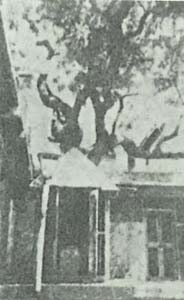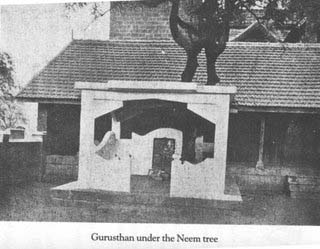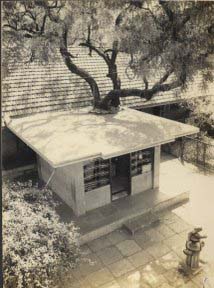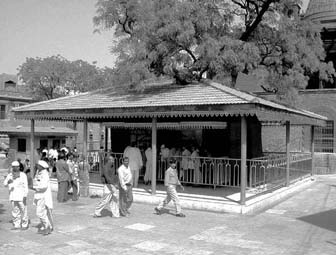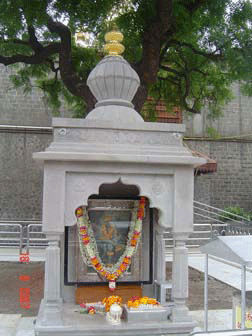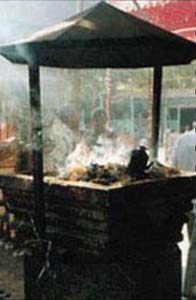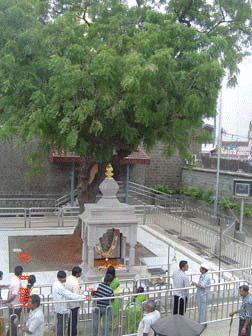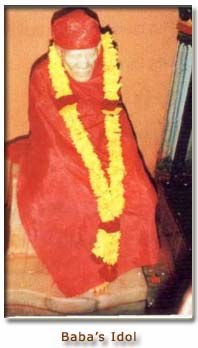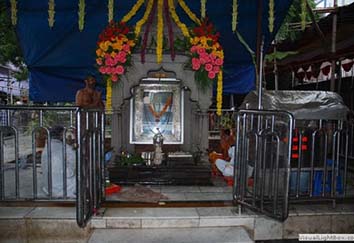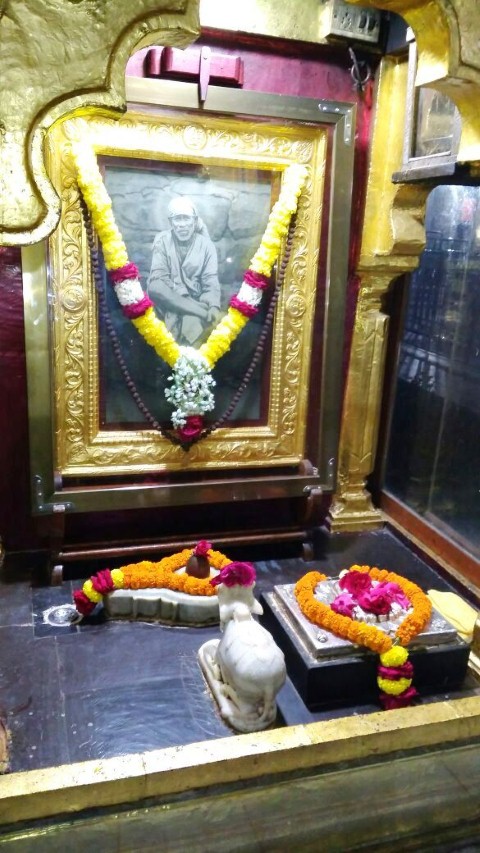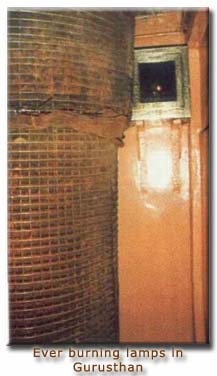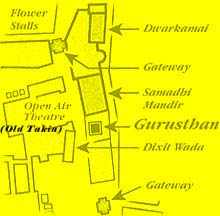GURU PADUKA'S STHAN OR GURUSTHAN & TAKIA
Baba first manifested Himself for the sake of His Bhaktas, under the neem (margosa) tree as a young lad of sixteen. The villagers were amazed to see His divine form and the hard penance that He did. He did not go to anybody's house and was oblivious of heat and rain and was in divine bliss. One day Lord Khandoba possessed the body of some devotee and the people asked him to inquire about this lad and whence He came from. Lord Khandoba asked them to bring a pickaxe and dig in a particular place. This was done. The cellar was 10’ in length and 10’ in breadth and 12’ high. Inside it they found a paat (flat stone). Under the flat stone were found four burning lamps and a corridor leading to a cellar where 'cow-mouth' (Goumukh) shaped seat, wooden boards, a Jaap Mala (rosary) were seen. Khandoba said this lad practiced penance for 12 years here. The people began to question the lad about this. He diverted the question by telling them that this was His Guru's place and requested them to guard it well. To prove his point he placed his right hand on a branch of the Neem tree. That was the branch facing the east and said “This is the truth, and from today the bitterness of this side of the Neem will disappear.” Thus it came to pass that the leaves on the right side are not bitter. The villagers then covered the portion that was dug. They placed the mud over as it was before. Then Baba said, “Anyone who applies slurry of cow dung on this area, on Thursday and Friday, and offers incense sticks, will be benefited greatly”. Devotees offer incense sticks in Gurusthan even to this day. (Ref. ESS, Ch.IV). Nobody knows who was Baba's Guru and His holy waten. As a reminiscence of Baba's first appearance in this place, devotees installed Padukas there.
Gurusthan is just behind Samadhi Mandir and is upon an alter about a foot high. There is only one step to climb in order to get into the temple. The wooden door of this temple is fitted with a grille so that devotees can have darshan even when the temple is closed. In the 1920’s the Gurusthan was a small temple facing west adjacent to the Neem tree. On Ashwin Shudh Dashmi, Shake 1863 (30th September 1941) a beautiful temple was reconstructed. This west facing temple was on a small platform, about 1’ high. It had bass relief peacocks, and flowers, and painted with delightfully bright colours. There was a small Kalasha on top.
In 1974, this small shrine was enclosed in a bigger temple. Baba’s idol was placed to the right of the small shrine, while the Neem tree was to the left of it. The marble padukas were in front of the Neem tree on a pedestal. Around April month of 2007, the Neem tree was drying up. Hence, the Shirdi Saibaba Sansthan got the horticulture department to treat it. Thus, the old Gurusthan structure had to be removed, so that the roots could get adequate supply of oxygen, nutrients and water. As Guru Poornima was fast approaching the present Gurusthan was constructed. This renovated Gurusthan Mandir got inaugurated on 11th July 2007 (ref: Shirdi Gazetteer).
THE SMALL DHUNI MAA This small Dhuni Maa is present in front of Gurusthan. Shirdi Saibaba Sansthan has made arrangement to offer Dhoop on every Thursday and Friday. Saibaba has assured that whoever offers Dhoop on Thursday’s and Friday’s, their wishes will be fulfilled. Earlier, the sacred fire was brought from Dwarakamai to Gurusthan everyday and Dhuni was lit by the Sansthan Poojari. Now this is being done only on Thursday’s and Friday’s.
Small Dhuni Maa THE SACRED NEEM TREE Just as the Audumbar and Aswatha trees are considered sacred, Baba held this Neem tree to be sacred. This blessed tree was there already, waiting for Baba to sit under her shade. It is believed that the Neem tree is the abode of the Goddesses and it is also referred to as “Neenari”. In Chaitra Masa after Amavasya Durga and Maha Kali reside on the tree. In 'Sai Mahima Sthothra', Upasini refers to this Neem tree as surpassing the 'Kalpa Vriksha' and showering Ambrosia of Baba's grace. Because Baba constantly sat under this Neem tree when He first came to Shirdi. The leaves are oozing nectar on account of the healing properties. Hence devotees worship this tree and eat its leaves mixed with pepper and sugar, as it has curative properties. Many devotees are relieved of their ailments by eating the leaves of this tree. 108 Pradakshina of Gurusthan is done by many devotees early in the morning, and at other times for destruction of their Karma, spiritual enlightenment and fulfillment of their wishes.
BABA’S IDOLThis Marble idol is 2'-6" in height, and is of “Baba sitting on the stone” posture. On Gurupoornima 1974 pratishta of this statue took place in Gurusthan with due formalities. Yashvanthrao D. Dave, a staunch devotee of Baba from Mumbai, donated the statue which was sculpted by Harish Balaji Thalim (son of late Balaji Vasanth Thalim, who had sculpted the Idol of Baba for the Samadhi Mandir).
In the year 2007, this idol was covered from head to toe and placed in the Museum to rejuvenate the Neem tree that was drying up due to lack of adequate supply of oxygen, nutrients and water. The Gurusthan was reconstructed and Baba’s Idol moved to Museum. BABA'S ORIGINAL PORTRAITA beautiful original portrait of Baba was installed, inside the small temple during Baba's lifetime. Arati was performed twice a day by Bapu Saheb Jog. This was later discontinued on Baba's advice. This photo is noteworthy for giving Sakshatkar and darshan of the Ishta Devata to many devotees. On 30th September 1952 which happened to be the 3rd day of the festival of Baba’s 34th Mahasamadhi, this original photograph was changed. Saibaba Sansthan Trust felt that the photograph was old. So it was replaced by a photograph donated by Shri.Narayanrao Devhare. At 11 am with due rituals the sthapana of the photograph was done by Shri.Vasantrao Narayan Gowrakshakar (Refer: Sai Leela Magazine. Ank 4. Year 29 October, November December 1952). Alankar is done by the Pujari in charge daily in the morning and bhog is offered at 11:30 am and in the evenings after Dhoop Aarti.
Babas portrait, Shivling & Nandi in Gurustan
Gurusthan Closer View (Courtesy:Shri.Nitin Mirane, Shirdi) SHIVA LINGA In front of Baba's photograph is this Shiva Linga. The Shiva Linga faces north, while the Nandi faces east and is in front of Baba’s photograph. Baba blessed Megha by giving him Sakshatkar and then gave him this Shiva LInga and a Nandi. Baba bestowed this favour on Megha by presenting him with a Shiva Linga following His order to draw a trident (Ref. ESS, Ch. XXVIII). Megha thus realised that Baba was none other than his Ishta Dev, Shiva. Following Mangal Snan of the Baba's statue, this Shiva Linga is bathed and adorned. On Maha Shivratri, Rudrabhishek and elaborate rituals are done at the time of Lingodbhav. This Shiva Linga was installed in 1912 after Megha passed away. BABA'S PADUKAS In Chapter 5 of the Shri Sai Satcharita the story of the Padukas are given. These marble Padukas are placed on a pedestal. The Story of Padukas (foot-prints) under the Neem Tree A devotee of Akkalkot Maharaj by name Bhai Krishnaji Alibagkar worshipped the photo of Akkalkot Maharaj. He once thought of going to Akkalkot (Sholapur District), taking the darshana of the Padukas (foot-prints) of the Maharaj and offering his sincere worship there; but before he could go there, he got a vision in his dream. Akkalkot Maharaj appeared in the vision and said to him - "Now Shirdi is my resting place, go there and offer your Worship." So Bhai changed his plan and came to Shirdi, worshipped Baba, stayed there for six months and was happy. As a reminiscence of this vision etc., he prepared the Padukas and installed them on an auspicious day of Shravan, Shaka 1834 (27th August 1912) under the Neem tree with due ceremonies and formalities, conducted by Dada Kelkar and Upasani. One Dixit Brahmin was appointed for worship, and the management was entrusted to devotee Sagun. Complete Version of this Story Mr. B.V. Deo, Retired Mamalatdar of Thana, and a great devotee of Sai Baba, made enquired about this matter with Sagun Meru Naik and Govind Kamlakar Dixit and has published a full version of the Padukas in Sai Leela Vol. 11, No. 1, page 25. It runs as follows: In 1834 Shaka (27th August 1912) one Doctor Ramarao Kothare of Bombay came to Shirdi for Baba’s darshana. His compounder; and his friend, Bhai Krishnaji Alibagkar, accompanied him. The compounder and Bhai became intimate with Sagun Meru Naik and G.K. Dixit. While discussing things, these persons thought that there must be some memorial of the fact of Sai Baba’s first coming to Shirdi and sitting under the holy Neem tree. They thought of installing Baba’s Padukas there and were going to make them of some rough stones. Then Bhai’s friend, the compounder, suggested that if this matter be made known to his master, Dr. Ramarao Kothare, who would prepare nice Padukas for this purpose. All liked the proposal and Dr. Kothare was informed of it. He came to Shirdi and drew a plan of the Padukas. He went to Upasani Maharaj in Khandoba’s temple, and showed him his plan. The latter made many improvements, drew lotuses, flowers, conch, disc, man etc., and suggested that the following SHLOKA (verse) regarding Neem tree’s great ness and Baba’s Yogi powers be inscribed. The verse was as follows: "Sada Nimbarvrikshasya mooladhiwasat, Upasani’s suggestions were accepted and carried out. The Padukas were made in Bombay and sent to Shirdi with the compounder. Baba said that they should be installed on the Pournima (15th) of Shravan. On that day at 11 a.m., G.K. Dixit brought them on his head from Khandoba’s temple to the Dwarkamai (Masjid) in procession. Baba touched the Padukas, saying that these are the feet of the Lord and asked the people to instal them, under foot of the Neem tree. A day before, one Parsi devotee of Bombay named Pastha Shet sent Rs.25/- by money order. Baba gave this sum for the installation of the Padhukas. The total expense of installation came up to Rs.100/- out of which Rs.75/ - were collected by subscriptions. For the first 5 years, G.K. Dixit worshipped the Padukas daily and then Laxman Kacheshwar Jakhadi did this. In the first five years, Dr. Kothare sent Rs. 2 per month for lighting and he also sent the railing round the Padukas. The expense of bringing the railing from the station to Shirdi (Rs. 7-8-0) (presently Rs.7.50p) and roofing was paid by Sagun Meru Naik. During later years, Jakhadi (Nana Pujari) did the worship and Sagun Meru Naik offered the naivaidya and lights the evening lamps. Bhai Krishnaji was orginally a devotee of Akkalkot Maharaj. He had come to Shirdi at the installation of the Padukas, in Shaka 1834 on his way to Akkalkot. He wanted to go to Akkalkot after taking the darshana of Baba. He asked Baba’s permission for this. Baba said - "Oh, what is there in Akkalkot? Why do you go there? The incumbent Maharaj of that place is here, Myself." Hearing this Bhai did not go to Akkalkot. He came to Shirdi off and on, after the installation of the Padukas. Now the Sansthan pujari does abhishek and alankar daily. THE EVER BURNING LAMPS The two ever burning lamps were placed on the wall on either side of the Neem tree. They were enclosed in a silver casing with a glass door. They were placed at a height of about 5’ so that the Pujari could attend to them easily. Daily the wicks were trimmed, replenished with oil, and new wicks used whenever necessary. This was done without allowing the Jyothi (Lit end) to be extinguished, as the Jyothi is burning since Baba’s time. Following the installation of the Padukas, Dr. Kothari sent Rs.2/- per month for lighting the lamps. Then Shagun Meru did the service. Now the Sansthan does this (Ref. ESS, Ch. V). Since Guru Poornima of 2007, there is only one small “Ever Burning Lamp”. This lamp is kept in the right hand corner and towards the front of Baba’s photograph. This photograph gives a view of the interior of the Gurusthan in days gone by. The devotees can see for themselves what it looks like now.
Daily programme at Gurusthan is given below for the benefit of Sai Devotees.
Lingodbhav Puja is done on the day of Maha Shivaratri. THE TAKIYA OR ASOOL GARH This was a spacious room used by Fakirs. When they go on pilgrimages they can break journey and stay in a Takiya. A Takiya is a resting place for visiting fakirs. Before Baba came to live in the Masjid, he stayed in this Takiya for some time when he first came to Shirdi. Sai Baba had a great love of music and dance. In His early days He would often go by the Takiya and sing devotional songs, usually in Arabic or Persian, or the (Hindi) songs of Kabir. His voice is described as “very sweet and appealing”. Sometimes he tied Ghungrus (small bells) on his ankles and danced with abandon around in ecstasy while singing, probably in the company of visiting fakirs who were putting up here for a night or two. (Refer Sai Satcharitra Chapter 5).
This Takiya was located in front of the “exit gate” on the northern wall of the Samadhi Mandir. Just across from Gurusthan, to the east of Dixit Wada opposite the neem tree, near to where an open theatre has recently been built, there used to be a Takiya or small shed. Later on this room was used as an Udi Distribution Centre. After Kakad Arati this room was used to distribute Prasad and Baba’s Tirth. Most recently, this room is used as an announcement centre.
Even though the Takiya is not there any more, one can easily imagine the scenes of ecstatic devotion that were creatively enacted here during the night hours.
|
(Source: Ambrosia in Shirdi, Baba’s Gurukul by Vinny Chitluri and English Sai Satcharitha Chapter V published by Shirdi Saibaba Sansthan). |
|---|
